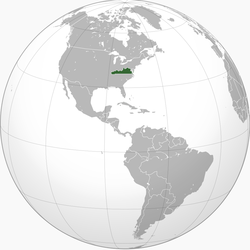
Back Firginiæ þǣre Landgebūnes ANG مستعمرة فرجينيا Arabic Colònia de Virgínia Catalan Kolonien Virginia Danish Colony of Virginia German Kolonio de Virginio Esperanto Colonia de Virginia Spanish مستعمره ویرجینیا Persian Virginian siirtokunta Finnish Colonie de Virginie French
Colony of Virginia | |||||||||
|---|---|---|---|---|---|---|---|---|---|
| 1606–1776 | |||||||||
Motto:
| |||||||||
Seal | |||||||||
 The Colony of Virginia with current country borders | |||||||||
 | |||||||||
| Status | Proprietary colony (1606–1624) Crown colony (1624–1776) | ||||||||
| Capital |
| ||||||||
| Common languages | English Siouan Iroquoian Algonquian | ||||||||
| Religion | Church of England (Anglicanism)[2] | ||||||||
| Government | |||||||||
• Monarch | (First) James VI & I (Last) George III | ||||||||
| Governor | |||||||||
• 1584 | Edward Wingfield (First) | ||||||||
• 1776 | Lord Dunmore (Last) | ||||||||
| Legislature | General Assembly | ||||||||
• Upper House | Governor's Council (1607–1776) | ||||||||
• Lower House | House of Burgesses (1619–1776) | ||||||||
| Historical era | European colonization of the Americas | ||||||||
• Roanoke, Virginia: Origins Founding | April 10, 1606 | ||||||||
• Became royal colony | May 24, 1624 | ||||||||
| July 4, 1776 | |||||||||
| Currency | Virginia pound (1624–1793) | ||||||||
| |||||||||
| Today part of | |||||||||
The Colony of Virginia was an English, later British, colonial settlement in North America between 1606 and 1776.
The first effort to create an English settlement in the area was chartered in 1584 and established in 1585; the resulting Roanoke Colony lasted for three attempts totaling six years. In 1590, the colony was abandoned. But nearly 20 years later, the colony was re-settled at Jamestown, not far north of the original site. A second charter was issued in 1606 and settled in 1607, becoming the first enduring English colony in North America. It followed failed attempts at settlement on Newfoundland by Sir Humphrey Gilbert[3] in 1583 and the Roanoke Colony (in modern eastern North Carolina) by Sir Walter Raleigh in the late 1580s.
The founder of the second colony was the Virginia Company,[4] chartered by King James I, with its first two settlements being in Jamestown on the north bank of the James River and Popham Colony on the Kennebec River in modern-day Maine, both in 1607. The Popham colony quickly failed because of famine, disease, and conflicts with local Native American tribes in the first two years. Jamestown occupied land belonging to the Powhatan Confederacy; it was also on the brink of failure before the arrival of a new group of settlers and supplies by ship in 1610. Tobacco became Virginia's first profitable export, the production of which had a significant impact on the society and settlement patterns.
In 1624, the Virginia Company's charter was revoked by King James I, and the Virginia Colony was transferred to royal authority as a crown colony. After the English Civil War in the 1640s and 1650s, the Virginia colony was nicknamed "The Old Dominion" by King Charles II for its perceived loyalty to the English monarchy during the era of the Protectorate and Commonwealth of England.[5]
From 1619 to 1775/1776, the colonial legislature of Virginia was the General Assembly, which governed in conjunction with a colonial governor. Jamestown remained the capital of the Virginia Colony until 1699; from 1699 until its dissolution, the capital was in Williamsburg. The colony experienced its first significant political turmoil with Bacon's Rebellion of 1676.
After declaring independence from the Kingdom of Great Britain in 1775, before the Declaration of Independence was officially adopted, the Virginia Colony became the Commonwealth of Virginia, one of the original thirteen states of the United States, adopting as its official slogan "The Old Dominion". The entire modern states of West Virginia, Kentucky, Indiana, and Illinois, and portions of Ohio and Western Pennsylvania were later created from the territory encompassed, or claimed by, the colony of Virginia at the time of further American independence in July 1776.
- ^ "The Library of Virginia FAQ About Virginia".
- ^ Edward L. Bond, "Anglican theology and devotion in James Blair's Virginia, 1685–1743", Virginia Magazine of History and Biography, 1996, Vol. 104 Issue 3, pp. 313–340
- ^ Gilbert (Saunders Family), Sir Humphrey" (history), Dictionary of Canadian Biography Online, University of Toronto, May 2, 2005
- ^ "Instructions for the Virginia Colony 1606". American history from revolution to reconstruction. Retrieved June 22, 2017.
- ^ Tarter, Brent. "Old Dominion". Encyclopedia Virginia. Virginia Foundation for the Humanities. Retrieved November 29, 2016.

